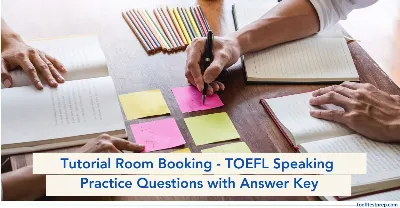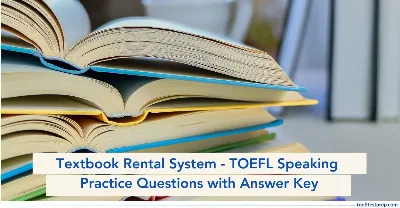Augmented Reality in Education - TOEFL iBT® Reading Practice Test

"Improve your skills for the TOEFL Reading section with our practice passage on 'Augmented Reality in Education,' exploring how AR technology is revolutionising the classroom."
Key Highlights
In the TOEFL Reading section, you may encounter passages about topics like 'Augmented Reality in Education,' which discusses how AR is reshaping the way students interact with learning materials. Practicing with readings on this topic will help you understand how technology is being used to enhance the educational experience.
By reading passages about AR, you will improve your ability to analyse complex technological ideas and prepare for test questions effectively.
Reading Instructions:
- You have 15 minutes to read the following passage and answer all 9 questions related to it.
- Most questions are worth 1 point, but the last question is worth more. The directions indicate how many points you will receive for that specific question.
- The specific section/paragraphs have been provided again with the question for ease of understanding and quick solution.
- Some questions include a word or phrase that is highlighted in the question as well as in the paragraph for quick reference.
Augmented Reality in Education
Enhanced reality (AR) has become an important technology in education, offering new ways to enhance learning experiences. By overlaying digital information onto the real world, AR allows students to engage with educational content in a more interactive and engaging way. This technology is being used in various educational settings, from primary schools to universities, as it provides hands-on learning opportunities that traditional methods often lack. The use of AR in educational courses is not just a trend; it marks a significant change in teaching methods, helping students understand and remember information better. Developments in AR technology, especially since the early 2000s, have paved the way for its current use in classrooms, making it a relevant topic in todays educational discussions.
One of the main benefits of AR in education is its ability to support hands-on learning. For example, students studying biology can use AR apps to visualize complex structures like the human body or cellular processes in three dimensions. This visualization allows learners to interact with the subject, improving their understanding. Research by educators shows that students who engage with AR content remember information up to 30% better than those who rely only on textbooks or lectures. Also, AR can cater to different learning styles, helping visual, auditory, and kinesthetic learners by providing various ways to engage. As a result, using AR not only enhances the learning experience but also promotes inclusivity in classrooms.
But implementing AR in education comes with obstacles. One major obstacle is access to the technology itself. While AR apps are becoming more available, not all schools have the necessary hardware or software to support them. Theres also a learning curve for both teachers and students as they adapt to this new technology. Teachers need proper training to effectively include AR in their lessons, and students may need help navigating AR apps. So, successfully adopting AR in education requires a focused effort to tackle these practical and teaching challenges. Also, funding for such technology can be a limiting factor, especially in under-resourced schools, which may struggle to keep up with technological changes.
Furthermore, the effectiveness of AR in education can vary based on how its used. For instance, while AR has shown promise in subjects like science and math, its use in the humanities may not engage students as much. Critics argue that the newness of AR can sometimes distract from its educational value, leading to shallow learning experiences. A study from 2019 found that students using AR in history classes reported higher engagement levels, but their retention of factual information did not improve significantly compared to traditional methods. So, its important for educators to carefully consider whether AR is suitable for specific learning goals and to ensure its use is effective rather than just a trick.
Despite these challenges, many case studies show the potential of AR to enhance educational experiences. For example, a pilot program in a secondary school used AR to teach history by letting students interact with historical artifacts in a virtual setting. This approach not only captured students' interest but also helped them appreciate historical situations more deeply. Similarly, universities have started to include AR in their programs, allowing students to conduct virtual experiments in fields like chemistry and engineering. In one notable case, a university in the UK used AR to simulate chemical reactions, letting students visualize molecular interactions that would be impossible to see in a regular lab. These examples highlight how AR can enhance engagement and understanding across different subjects.
In conclusion, while using enhanced reality in education brings both opportunities and challenges, its potential to transform learning experiences is clear. As schools continue to explore new teaching methods, AR stands out as a promising way to boost engagement and improve understanding. However, for AR to reach its full potential, teachers need proper training and resources, and the technology must be thoughtfully integrated into the curriculum. Future research should focus on long-term studies to evaluate AR's impact on learning outcomes and retention. As education evolves, exploring AR's capabilities will likely provide valuable insights into its role in shaping the future of learning, leaving many questions about its best use in various educational situations.
Directions: Once you have read the passage, answer the following questions.
Paragraph 1
Enhanced reality (AR) has become an important technology in education, offering new ways to enhance learning experiences. By overlaying digital information onto the real world, AR allows students to engage with educational content in a more interactive and engaging way. This technology is being used in various educational settings, from primary schools to universities, as it provides hands-on learning opportunities that traditional methods often lack. The use of AR in educational courses is not just a trend; it marks a significant change in teaching methods, helping students understand and remember information better. Developments in AR technology, especially since the early 2000s, have paved the way for its current use in classrooms, making it a relevant topic in todays educational discussions.
Factual Information Question
- According to paragraph 1, what is one significant change that AR technology brings to education?
- It replaces traditional textbooks entirely.
- It allows for hands-on learning opportunities.
- It is only used in primary schools.
- The ability to overlay digital information onto the real world.
Negative Factual Information Question
- The author mentions all of the following as benefits of AR in education EXCEPT:
- Improved engagement with educational content.
- Enhanced memorisation of information.
- A decrease in the use of traditional teaching methods.
- The ability to overlay digital information onto the real world.
Paragraph 2
One of the main benefits of AR in education is its ability to support hands-on learning. For example, students studying biology can use AR apps to visualize complex structures like the human body or cellular processes in three dimensions. This visualization allows learners to interact with the subject, improving their understanding. Research by educators shows that students who engage with AR content remember information up to 30% better than those who rely only on textbooks or lectures. Also, AR can cater to different learning styles, helping visual, auditory, and kinesthetic learners by providing various ways to engage. As a result, using AR not only enhances the learning experience but also promotes inclusivity in classrooms.
Inference Question
- What can be inferred about the impact of AR on different types of learners?
- AR is only beneficial for visual learners.
- AR may help all types of learners by providing diverse engagement methods.
- AR is ineffective for auditory learners.
- AR primarily benefits kinesthetic learners.
Rhetorical Purpose Question
- Why does the author provide the example of students studying biology using AR apps?
- To illustrate the limitations of AR in education.
- To demonstrate how AR can improve understanding through visualisation.
- To argue that AR is only useful in science subjects.
- To show that AR is a passing trend in education.
Paragraph 3
But implementing AR in education comes with obstacles. One major obstacle is access to the technology itself. While AR apps are becoming more available, not all schools have the necessary hardware or software to support them. Theres also a learning curve for both teachers and students as they adapt to this new technology. Teachers need proper training to effectively include AR in their lessons, and students may need help navigating AR apps. So, successfully adopting AR in education requires a focused effort to tackle these practical and teaching challenges. Also, funding for such technology can be a limiting factor, especially in under-resourced schools, which may struggle to keep up with technological changes.
Vocabulary Question
- The word "obstacle" in paragraph 3 is closest in meaning to:
- Advantage
- Challenge
- Opportunity
- Solution
Sentence Simplification Question
-
Which of the sentences below best expresses the essential information in the following text from paragraph 3?
"Successfully adopting AR in education requires a focused effort to tackle these practical and teaching challenges."
- Adopting AR in education is easy and straightforward.
- Implementing AR in education involves overcoming various challenges.
- Teachers find it difficult to use AR in their lessons.
- AR technology is not suitable for education.
Paragraph 4
Furthermore, the effectiveness of AR in education can vary based on how its used. For instance, while AR has shown promise in subjects like science and math, its use in the humanities may not engage students as much. Critics argue that the newness of AR can sometimes distract from its educational value, leading to shallow learning experiences. A study from 2019 found that students using AR in history classes reported higher engagement levels, but their retention of factual information did not improve significantly compared to traditional methods. So, its important for educators to carefully consider whether AR is suitable for specific learning goals and to ensure its use is effective rather than just a trick.
Prose Summary Question
- Which of the following best summarises the main point of paragraph 4?
- AR is equally effective in all subjects.
- The effectiveness of AR varies by subject and requires careful consideration.
- AR is a distraction in educational settings.
- Students prefer traditional methods over AR.
Paragraph 5
Despite these challenges, many case studies show the potential of AR to enhance educational experiences. For example, a pilot program in a secondary school used AR to teach history by letting students interact with historical artifacts in a virtual setting. This approach not only captured students' interest but also helped them appreciate historical situations more deeply. Similarly, universities have started to include AR in their programs, allowing students to conduct virtual experiments in fields like chemistry and engineering. In one notable case, a university in the UK used AR to simulate chemical reactions, letting students visualize molecular interactions that would be impossible to see in a regular lab. These examples highlight how AR can enhance engagement and understanding across different subjects.
Insert Missing Sentence Question
-
In paragraph 5, there is a missing sentence. The paragraph is repeated below and shows four letters (A, B, C, and D) that indicate where the following sentence could be added.
"These innovative applications demonstrate the versatility of AR in various educational contexts." Where would the sentence best fit?
- Despite these challenges, many case studies show the potential of AR to enhance educational experiences.
- For example, a pilot program in a secondary school used AR to teach history by letting students interact with historical artifacts in a virtual setting.
- Similarly, universities have started to include AR in their programs, allowing students to conduct virtual experiments in fields like chemistry and engineering.
- In one notable case, a university in the UK used AR to simulate chemical reactions, letting students visualize molecular interactions that would be impossible to see in a regular lab.
Paragraph 6
In conclusion, while using enhanced reality in education brings both opportunities and challenges, its potential to transform learning experiences is clear. As schools continue to explore new teaching methods, AR stands out as a promising way to boost engagement and improve understanding. However, for AR to reach its full potential, teachers need proper training and resources, and the technology must be thoughtfully integrated into the curriculum. Future research should focus on long-term studies to evaluate AR's impact on learning outcomes and retention. As education evolves, exploring AR's capabilities will likely provide valuable insights into its role in shaping the future of learning, leaving many questions about its best use in various educational situations.
Purpose of the Passage Question
- What is the main purpose of the passage?
- To argue against the use of AR in education.
- To discuss the benefits and challenges of AR in educational settings.
- To provide a historical overview of AR technology.
- To promote traditional teaching methods over new technologies.
Prose Summary Question
Directions: An introductory sentence for a brief summary of the passage is provided below. Complete the summary by selecting the THREE answer choices that express the most important ideas in the passage. Some sentences do not belong in the summary because they express ideas that are not presented in the passage or are minor ideas in the passage. This question is worth 2 points.
- Enhanced reality (AR) has the potential to transform education by providing interactive learning experiences.
- AR can cater to different learning styles, promoting inclusivity in classrooms.
- The implementation of AR faces challenges such as access to technology and teacher training.
- AR is equally effective in all subjects, including the humanities.
- Case studies demonstrate AR's ability to enhance engagement and understanding across various subjects.
Answer Key with Explanation for TOEFL Reading Passage - Augmented Reality in Education
1. Answer: B
Explanation: The passage highlights that AR technology provides hands-on learning opportunities that traditional methods often lack. This is emphasized as a significant change in teaching methods, which enhances student engagement and understanding.
2. Answer: C
Explanation: While the passage discusses various benefits of AR, it does not explicitly state that it leads to a decrease in traditional teaching methods. Instead, it focuses on how AR enhances learning experiences without negating the existence of traditional methods.
3. Answer: B
Explanation: The passage indicates that AR caters to different learning stylesvisual, auditory, and kinestheticsuggesting that it can benefit a wide range of learners by offering various ways to engage with the material.
4. Answer: B
Explanation: The example illustrates the effectiveness of AR in helping students visualize complex biological structures, thereby enhancing their understanding. This supports the argument that AR can significantly improve learning experiences.
5. Answer: B
Explanation: The term "obstacle" refers to something that hinders progress or makes a task more difficult, which aligns closely with the meaning of "challenge." The passage discusses various challenges in implementing AR in education.
6. Answer: B
Explanation: This sentence succinctly captures the essence of the original text, which discusses the need for focused efforts to address the challenges associated with adopting AR in educational settings.
7. Answer: B
Explanation: The paragraph discusses how AR's effectiveness can differ across subjects, indicating that educators must thoughtfully assess its suitability for specific learning goals.
8. Answer: B
Explanation: The missing sentence fits best at the beginning of the paragraph, as it introduces the subsequent examples of AR applications in education, reinforcing the idea of AR's versatility.
9. Answer: B
Explanation: The passage provides a balanced view of both the advantages and obstacles associated with AR in education, making it clear that the author aims to inform readers about its potential and limitations.
10. Answer: A, B, D
Explanation: These choices encapsulate the key themes of the passage: the inclusivity of AR for different learning styles, the challenges in its implementation, and the positive outcomes evidenced by case studies. Choices C and E do not accurately reflect the passage's content.
Also Read:
- Icebergs - TOEFL Reading Practice Questions with Answer Key
- New Language - TOEFL Speaking Independent Practice Test Paper with Responses
- Serengeti Herbivores - TOEFL Reading Practice Test Paper with Answers
- The Easter Island - TOEFL Reading Practice Questions with Answer Key
- Theory of Evolution - TOEFL Reading Practice Test with Answer Key
Featured Articles

Marriage Across Cultures - TOEFL Reading Practice Test
Improve TOEFL Reading with passages on 'Marriage Across Cultures,' delving into unique traditions, values, and global perspectives on marriage.
July 15, 2025
Writing Center Services - TOEFL Speaking Practice Test with Answers (Integrated)
Prepare for the TOEFL Integrated Speaking section with a practice test on 'Writing Center Services' and learn to improve score in TOEFL exam.
July 15, 2025
Tutorial Room Booking - TOEFL Speaking Practice Test with Answers (Integrated)
Prepare for the TOEFL Integrated Speaking section with a practice test on 'Tutorial Room Booking ' and learn to improve score in TOEFL exam.
July 15, 2025
Textbook Rental System - TOEFL Speaking Practice Test with Answers (Integrated)
Prepare for the TOEFL Integrated Speaking section with a practice test on 'Textbook Rental System' and learn to improve score in TOEFL exam.
July 15, 2025